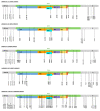Emergence of SARS-CoV-2 Variants in the World: How Could This Happen?
- PMID: 35207482
- PMCID: PMC8879166
- DOI: 10.3390/life12020194
Emergence of SARS-CoV-2 Variants in the World: How Could This Happen?
Abstract
The COVID-19 pandemic has had a significant global impact, with more than 280,000,000 people infected and 5,400,000 deaths. The use of personal protective equipment and the anti-SARS-CoV-2 vaccination campaigns have reduced infection and death rates worldwide. However, a recent increase in infection rates has been observed associated with the appearance of SARS-CoV-2 variants, including the more recently described lineage B.1.617.2 (Delta variant) and lineage B.1.1.529/BA.1 (Omicron variant). These new variants put the effectiveness of international vaccination at risk, with the appearance of new outbreaks of COVID-19 throughout the world. This emergence of new variants has been due to multiple predisposing factors, including molecular characteristics of the virus, geographic and environmental conditions, and the impact of social determinants of health that favor the genetic diversification of SARS-CoV-2. We present a literature review on the most recent information available on the emergence of new variants of SARS-CoV-2 in the world. We analyzed the biological, geographical, and sociocultural factors that favor the development of these variants. Finally, we evaluate the surveillance strategies for the early detection of new variants and prevent their distribution outside these regions.
Keywords: COVID-19; SARS-CoV-2; SARS-CoV-2 variants; developing countries; diagnosis; epidemiology; prognosis; social determinants of health.
Conflict of interest statement
The authors declare no conflict of interest.
Figures
References
-
- COVID-19 m–p—John Hopkins Coronavirus Resource Center. Jhu.Edu. [(accessed on 31 December 2021)]. Available online: https://coronavirus.jhu.edu/map.html.
-
- Harvey W.T., Carabelli A.M., Jackson B., Gupta R.K., Thomson E.C., Harrison E.M., Ludden C., Reeve R., Rambaut A., COVID-19 Genomics UK (COG-UK) Consortium et al. SARS-CoV-2 Variants, Spike Mutations and Immune Escape. Nat. Rev. Microbiol. 2021;19:409–424. doi: 10.1038/s41579-021-00573-0. - DOI - PMC - PubMed
Publication types
LinkOut - more resources
Full Text Sources
Miscellaneous



